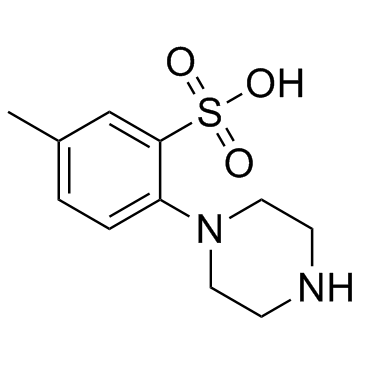Caldaret (MCC-135) (Synonyms: MCC-135) |
| Catalog No.GC34041 |
Caldaret (MCC-135) is an intracellular Ca2+ handling modulator that acts through reverse mode Na+/Ca2+ exchanger inhibition.
Products are for research use only. Not for human use. We do not sell to patients.

Cas No.: 133804-44-1
Sample solution is provided at 25 µL, 10mM.
Caldaret is an intracellular Ca2+ handling modulator that acts through reverse mode Na+/Ca2+ exchanger inhibition.
Caldaret (MCC-135) is demonstrated to restore Ca2+-ATPase activity of the sarcoplasmic reticulum (SR) isolated from the myocardium acutely exposed to ischemia and reperfusion in vitro[2].
Caldaret, an intracellular Ca2+ handling modulator, limits infarct size of reperfused canine heart. The cardioprotective effect of Caldaret, a novel intracellular Ca2+ handling modulator that acts through reverse-mode Na+/Ca2+ exchanger inhibition and potential sarcoplasmic reticulum (SR) Ca2+ uptake enhancement, against reperfusion injury is investigated. Intravenously infused Caldaret (3 or 30 microg/kg per hour) for 30 min at left circumflex (LCX)-reperfusion markedly reduces infarct size (by 51.3% or 71.9%, respectively). The amelioration of intracellular Ca2+ handling dysfunction achieved by Caldaret leads to cardioprotective effects against reperfusion injury following prolonged ischemia[1]. Caldaret (MCC-135) is a new potent compound with beneficial effects in heart failure. In diabetic rats, Caldaret decreases TR80 significantly without significant effect on developed tension (DT). Caldaret has minimal effects on SR Ca2+ uptake in normal rats, that is observed as increased SR Ca2+ uptake at uptake time of 20 and 30 s at the highest concentration of 10 μM. In diabetic rats, Caldaret increases SR Ca2+ uptake all over the range of uptake time. Both initial rate of SR Ca2+ uptake and the amount of Ca2+ accumulated in the SR with longer uptake time are increased by Caldaret[2].
[1]. Kawasumi H, et al. Caldaret, an intracellular Ca2+ handling modulator, limits infarct size of reperfused canine heart. J Pharmacol Sci. 2007 Feb;103(2):222-33. [2]. Satoh N, et al. Lusitropic effect of MCC-135 is associated with improvement of sarcoplasmic reticulum function in ventricular muscles of rats with diabetic cardiomyopathy. J Pharmacol Exp Ther. 2001 Sep;298(3):1161-6.
Average Rating: 5 (Based on Reviews and 36 reference(s) in Google Scholar.)
GLPBIO products are for RESEARCH USE ONLY. Please make sure your review or question is research based.
Required fields are marked with *




















